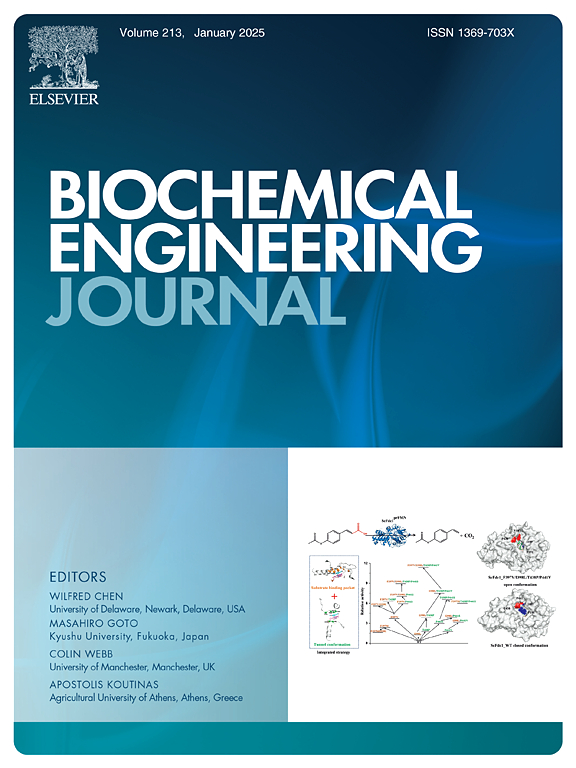One-pot synthesis of arginine decarboxylase@ZIF-8 using intrinsic pyridoxal 5′-phosphate cofactor for agmatine production
IF 3.7
3区 生物学
Q2 BIOTECHNOLOGY & APPLIED MICROBIOLOGY
引用次数: 0
Abstract
Agmatine is an important basic drug and nutritional supplements, which exhibits significant physiological activities. Traditional methods, such as whole-cell catalysis, require substantial pyridoxal 5′-phosphate (PLP) addition, which accounts for 15 % of production costs. In this study, we utilized purified arginine decarboxylase (AdiA-M2) that leverages the intrinsic PLP cofactor, without the need for additional PLP supplementation, and ZIF-8 was employed to enhance the pH tolerance. The successful incorporation of AdiA-M2 into the ZIF-8 structure was confirmed through scanning electron microscopy (SEM) and confocal laser scanning microscopy (CLSM). The immobilized arginine decarboxylase demonstrated markedly enhanced performance under alkaline conditions, along with improved thermal stability and storage activity compared to its free enzyme counterpart. Specifically, the immobilized AdiA@ZIF-8 system achieved an initial conversion rate of 95.16 %, after five recycles the titer attained 266.69 g/L without the extra PLP addition, which is 1.67 times higher than the best current production approach. The adopted enzyme-catalysis system eliminated the need for additional cofactors, thereby lowering costs and providing valuable insights for the industrial production of agmatine.
用内在吡哆醛5′-磷酸辅助因子一锅法合成精氨酸decarboxylase@ZIF-8
胍丁氨酸是一种重要的基础药物和营养补充剂,具有显著的生理活性。传统的方法,如全细胞催化,需要大量的吡哆醛5 ' -磷酸(PLP)添加,这占生产成本的15% %。在这项研究中,我们利用纯化的精氨酸脱羧酶(AdiA-M2),利用内在的PLP辅助因子,而不需要额外的PLP补充,并使用ZIF-8来增强pH耐受性。通过扫描电镜(SEM)和共聚焦激光扫描显微镜(CLSM)证实AdiA-M2成功融入ZIF-8结构。与游离酶相比,固定化的精氨酸脱羧酶在碱性条件下表现出明显增强的性能,以及更好的热稳定性和储存活性。具体而言,固定化AdiA@ZIF-8体系的初始转化率为95.16 %,在不添加PLP的情况下,经过5次循环,滴度达到266.69 g/L,比目前最佳生产方法提高了1.67倍。采用的酶催化系统消除了对额外辅助因子的需求,从而降低了成本,并为胍丁氨酸的工业生产提供了有价值的见解。
本文章由计算机程序翻译,如有差异,请以英文原文为准。
求助全文
约1分钟内获得全文
求助全文
来源期刊

Biochemical Engineering Journal
工程技术-工程:化工
CiteScore
7.10
自引率
5.10%
发文量
380
审稿时长
34 days
期刊介绍:
The Biochemical Engineering Journal aims to promote progress in the crucial chemical engineering aspects of the development of biological processes associated with everything from raw materials preparation to product recovery relevant to industries as diverse as medical/healthcare, industrial biotechnology, and environmental biotechnology.
The Journal welcomes full length original research papers, short communications, and review papers* in the following research fields:
Biocatalysis (enzyme or microbial) and biotransformations, including immobilized biocatalyst preparation and kinetics
Biosensors and Biodevices including biofabrication and novel fuel cell development
Bioseparations including scale-up and protein refolding/renaturation
Environmental Bioengineering including bioconversion, bioremediation, and microbial fuel cells
Bioreactor Systems including characterization, optimization and scale-up
Bioresources and Biorefinery Engineering including biomass conversion, biofuels, bioenergy, and optimization
Industrial Biotechnology including specialty chemicals, platform chemicals and neutraceuticals
Biomaterials and Tissue Engineering including bioartificial organs, cell encapsulation, and controlled release
Cell Culture Engineering (plant, animal or insect cells) including viral vectors, monoclonal antibodies, recombinant proteins, vaccines, and secondary metabolites
Cell Therapies and Stem Cells including pluripotent, mesenchymal and hematopoietic stem cells; immunotherapies; tissue-specific differentiation; and cryopreservation
Metabolic Engineering, Systems and Synthetic Biology including OMICS, bioinformatics, in silico biology, and metabolic flux analysis
Protein Engineering including enzyme engineering and directed evolution.
 求助内容:
求助内容: 应助结果提醒方式:
应助结果提醒方式:


